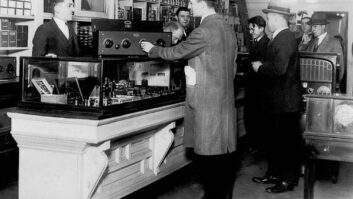For Entercom’s cluster of New Orleans stations, the road back to normal operations has taken some strange detours.
The big radio headline after Hurricane Katrina was the “United Radio Broadcasters” partnership between Entercom and Clear Channel, which used staffers from both companies to produce programming that was simulcast on both groups’ stations in New Orleans from Clear Channel’s studios in Baton Rouge.
As life – and radio – in the city began to settle down after the storm, United Radio Broadcasters came to an end in November, when the last of the Clear Channel stations that had been simulcasting the United programming returned to its regular format.
Southern hospitality
The cooperation between Clear Channel and Entercom continues, however, as Entercom’s WWL(AM) remains in the Baton Rouge Clear Channel studios.
“They’ve gone way out of their way to accommodate us,” said Marty Hadfield, Entercom’s vice president of engineering. “It’s really a nice situation for us to have a little breathing space on WWL,” as the station waits to be able to move back home.
For the rest of Entercom’s cluster – another AM facility and four FMs – the road back to New Orleans is running through the former Jefferson Parish Administration Building in suburban Gretna.
That facility, across the Mississippi River from the former Entercom studios in New Orleans’ central business district, was scheduled for demolition even before Katrina swept through the region.
Now, one floor of the building is being used as office space for the Entercom stations. The other floor has been converted into temporary studio space for the three FMs – top 40 WEZB(FM), classic rock WKBU(FM) and adult contemporary WLMG(FM) – that returned to their normal programming in November.
A fourth FM, WTKL(FM), suffered serious damage at its transmitter site and is being operated from a low-power auxiliary transmitter as a relay of WWL’s news-talk programming; the second AM, WSMB(AM), runs automated Air America programming.
“It’s really just a voice room per station,” Hadfield said of the temporary facility known internally as “JAB.”
Each station was initially linked by a Marti RPU (since replaced by ISDN lines) to the main Entercom studios across the river, where Dalet automation continues to play out music, liners and spots.
“We have limited access to our former studios,” Hadfield said. “The building is only open during business hours,” due to security concerns and lack of running water in the area. Entercom is the only tenant that has returned to the Poydras Street office tower since Katrina.
Each morning at 8 a.m., Entercom’s production and traffic staff go to the former main studios to spend the day loading the Dalet system with spots and production material. On the other side of the river, each station’s airstaff reports to “JAB” to go on the air from a small studio equipped with just a microphone and a small mixer.
Initially, Hadfield said, the talent at “JAB” used touchtones to control the Dalet system, with filtering at the studio end of the Marti used to keep the DTMF tones out of the broadcast audio. With the switch to ISDN, the talent now has full remote access to the Dalet, making the “JAB” facility function much like any other remote broadcast – one that runs live 24 hours a day, seven days a week.
Coming home
The goal is to fully return to the Poydras Street studios. Hadfield says the fifth-floor facility rode out the storm fairly well, losing exterior glass and suffering water damage to the studios that lined one of the outside walls.
Entercom had its own generator and air-conditioning system, which continued to function even after the building’s main chiller system was shut down. Hadfield said a test of the air quality in the fifth-floor studios found that the indoor air was better than the air at street level outside the building.
“Right now, we’re trying to determine what our prospects are, facility-wise and time-wise, to move WWL back,” Hadfield said.
For the moment, WWL is using a Louisiana Network satellite uplink to feed its programming from the Clear Channel Baton Rouge studios back to the New Orleans studios, where spots are played out of the Dalet system.
News reporters in New Orleans gather their material on laptops, then use Verizon Wireless’ data network to send the files to Baton Rouge, where Clear Channel has loaned WWL a portion of its Prophet Systems automation system to store news audio.
Entercom also faces rebuilding work at its four transmitter sites around New Orleans. Hadfield said the WWL site, in a bayou south of the city, suffered no significant damage from the storm, except for the washout of the private road that leads to the facility.
Entercom worked with FEMA to upgrade the generators at the site, installing two new generators and a new elevated fuel tank. An overcrank problem with the former generator at the site took WWL off the air for several hours at the height of Katrina.
When the project is finished, the main generator will feed WWL’s 50 kW transmitter and its two-tower directional antenna, while the auxiliary generator will serve the 10 kW backup transmitter and a long-wire emergency antenna, providing a completely separate emergency facility at the site.
The American Tower-owned site where three of the Entercom FMs are located also survived the storm well. It will become home, at least temporarily, to the fourth Entercom FM (WTKL 105.3) as well, since the “BBT Tower” where that station was located suffered severe damage and will be unusable for some time to come.
The site was co-owned with a Clear Channel FM station that also is using the American site and with a public TV station, WLAE, which remains off the air.
For now, a low-power transmitter at the American Tower site is providing a minimal signal on 105.3. Entercom hopes to take one of the new Harris HD Radio transmitters it had ordered before the storm and use its analog-only capability to restore a full-power 105.3 signal from the American Tower facility, once equipment becomes available.
Entercom’s fourth site, the WSMB(AM) facility, suffered some building damage, but the station remains on the air.
“I’m just proud of our people,” Pollet said, “and thrilled that the Clear Channel people have risen to the occasion right alongside us.”












